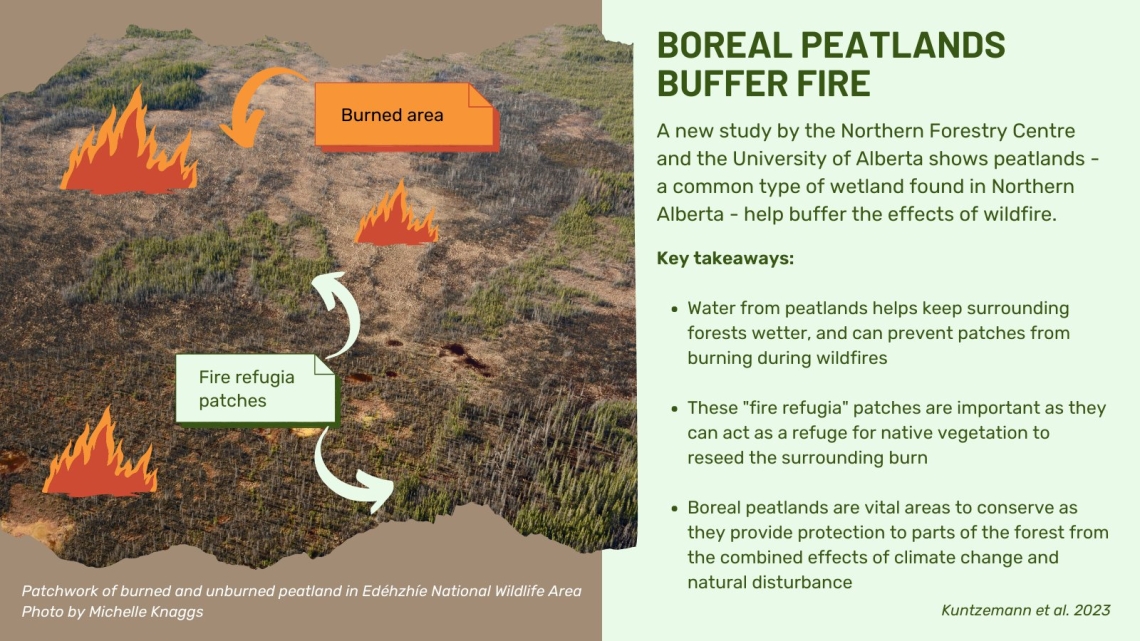Habitat management
Content related to: Habitat management
Do Beaver Ponds Increase Methane Emissions Along Arctic Tundra Streams?
Occupancy and Abundance of Pond-Breeding Anurans in Boreal Landscapes
Controls on Methylmercury Concentrations in Lakes and Streams of Peatland-Rich Catchments Along a 1700 km Permafrost Gradient
Peatlands Reduce Fire Severity and Promote Fire Refugia in Boreal Forests

In the boreal biome of North America, large wildfires usually leave behind residual patches of unburned vegetation, termed refugia, which can strongly affect post-fire ecosystem processes. While topographic complexity is a major driver of fire refugia in mountainous terrain, refugia and fire severity (the ecological impacts of fire) in boreal landscapes are more likely driven by bottom-up controls affecting the extent and type of fuels. In this study, I investigate the role of hydrological (e.g., peatlands), ecological, and topographic heterogeneity on fire severity and the presence of fire refugia under different spatial and temporal climate moisture conditions in the Alberta boreal region over a 33-year (1985-2018) period. Fire severity was measured using the Relativized Burn Ratio (RBR). Generalized linear models were used to examine relationships of fire severity and probability of refugia as a function of bottom-up (vegetation, topography, site moisture, ecosystem) and top-down (normal and annual climatic moisture) controls. I then developed predictive maps of refugia probability and fire severity under normal and inter-annual climatic moisture conditions. I found that peatlands, stratified as bogs and fens, burned at lower severities and exhibited a higher probability of refugia than uplands, with vegetation (fuel) presenting a stronger control on fire than climate, topography, site moisture, or ecosystem type. In general, locations with wetter regional (normal) climatic moisture, a proxy for fuel amount, experienced increased fire severity and refugia probabilities when surrounded by more peatlands. While the amount of bogs affected both fire severity and refugia at intermediate scales (900-m area), fens affected fire severity most strongly when at a landscape scale (3000-m area) and refugia when at a local-scale (120-m area). Bogs decreased fire severity in adjacent uplands and peatlands under all regional and annual climatic moisture conditions but did not affect refugia probability in uplands. Fens reduced fire severity in adjacent uplands under all conditions and had varying effects on adjacent peatlands depending on moisture availability. Fens also increased refugia probability in adjacent uplands under all conditions, as well as in adjacent peatlands under all regional climatic moisture conditions. Areas of hydrologically-connected peatlands, particularly fens, may be capable of slowing future vegetation transitions, stemming from climate-driven increases to fire severity and post-disturbance moisture stress, in neighboring forests.
Read the full paper here.
Wetland Knowledge Exchange June 2023 Newsletter
How do peatlands impact wildfires?

This spring, hot temperatures and tinder-dry conditions have resulted in rampant wildfires, causing devastating property damage and smoky conditions across Canada. While wildfire is an integral part of the boreal ecosystem—in part, driving vegetation and soil dynamics—healthy peatlands can help mitigate some of the impacts.
Peatlands are wetland ecosystems that are found throughout Canada’s boreal region. They are characterized by deep, decaying vegetation deposits, or peat, built up below the ground surface. These deposits can be thousands of years old and are particularly good at holding water. For this reason, patches of peatland can remain unburned or burn at low severity and are often described as “fire refugia.”
Keep reading here.
Wetland and Water Quality Management

Wetlands provide irreplaceable ecosystem services and are particularly important for water quality. Wetlands can act as nutrient sinks for common nutrients such as phosphorus. As water moves across the landscape, wetlands work to reduce direct surface water drainage into lakes and filter these nutrients out and store them. However, when wetlands are removed from the landscape, these areas may become a source of phosphorus and other contaminants resulting in lower water quality in lakes.
In Alberta, many lakes in the southern parts of the province suffer from increased nutrient loading, resulting in blue-green algae blooms. Toxic blue-green algae can lead to a decline in dissolved oxygen and thus decrease habitat quality for fish and other aquatic wildlife. The removal of wetlands not only affects wildlife but can also decrease the effectiveness of water treatment facilities. Learn more about the importance of wetlands and nutrient filtering in a presentation by Ducks Unlimited Canada’s Tracy Scott here.

